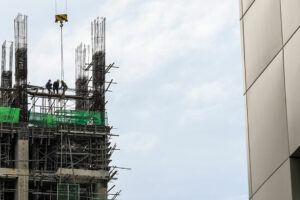Price growth of building materials in Metro Manila slows in January
Price growth of construction materials in the National Capital Region (NCR) eased in January amid lower interest rates and a weaker peso, the Philippine Statistics Authority (PSA) reported on Friday. According to preliminary data, the January construction materials retail price index (CMRPI) slowed to 1.2% in January, from 1.5% recorded in December and 1.4% reported […]

Price growth of construction materials in the National Capital Region (NCR) eased in January amid lower interest rates and a weaker peso, the Philippine Statistics Authority (PSA) reported on Friday.
According to preliminary data, the January construction materials retail price index (CMRPI) slowed to 1.2% in January, from 1.5% recorded in December and 1.4% reported in the same month last year.
Growth in the CMRPI in the National Capital Region (NCR) was the weakest in five months or since the 1.1% in August 2024.
“A weaker peso has made imported construction materials cheaper,” Cid L. Terosa, senior economist at the University of Asia and the Pacific, said in an e-mail interview.
The peso ended at P58.365 against the dollar in January, weakening from P57.845 at end-December 2024.
Mr. Terosa also said that lower interest rates have restrained the cost of production of construction materials.
Last year, the Bangko Sentral ng Pilipinas brought a total of 75 basis points in rate cuts since the beginning of its easing cycle in August, bringing the key rate to 5.75%.
“Lower demand for construction materials due to relatively fewer construction activities amidst the glut in residential and office buildings and units has contributed to slower price increases in prices across most construction materials,” Mr. Terosa said.
The PSA also said that the main factor behind NCR’s slower annual CMRPI increase was the deceleration in the heavily weighted tinsmithry materials index, which rose by 1.6% in January, down from 2.6% in December 2024.
Tinsmithry materials form the largest commodity group in the index, accounting for 21.76% of the CMRPI.
Other commodity groups also reported slower price growths, such as electrical materials (1.8% from 1.9%), painting materials and related compounds (2.2% from 2.6%), plumbing materials (0.8% from 1%), and miscellaneous construction materials (0.6% from 0.8%).
Only carpentry materials saw price increase at 1%, from 0.8% last month.
In a separate report by the PSA, the construction materials wholesale price index (CMWPI) cooled to a record 0.1%, lower than 0.2% in December and 1.5% in January last year.
The CMRPI is based on 2012 constant prices, while the CMWPI is based on 2018 constant prices.
Of the 20 categories, four commodities saw accelerated price growths, six saw easing growth, four were unchanged, and six commodities posted price declines.
The PSA attributed the slower annual CMWPI growth primarily to prices in reinforcing steel and PVC pipes, which declined by 0.3% (from 1.2%) and 0.1% (from 0.9%), respectively.
Other categories where rates went down were hardware (0.1% from 0.7%), G.I. sheet (0.3% from 0.4%), structural steel (-0.9% from -0.5%), metal products (0% from 0.1%), electrical works (0.3% from 0.4%), plumbing fixtures and accessories or waterworks (0.7% from 1.2%), painting works (1.1% from 1.2%), and fuels and lubricants (-3.4% from -1.2%).
The indices for concrete products, glass and glass products, asphalt, and machinery and equipment rental did not change.
Mr. Terosa said that US President Donald J. Trump’s trade policies and trade wars between major exporters of construction materials are key factors to consider in the coming months.
Since taking office in January, Mr. Trump has imposed tariffs on Chinese imports while putting on hold the duties on products from Mexico and Canada.
He is also mulling on slapping “reciprocal tariffs” on every country taxing US imports, stoking fears of wider global trade war, Reuters reported.
“If the downward trend in prices across most construction materials will continue despite the tense global trade environment, construction activity and real estate development in the NCR will benefit.” — Pierce Oel A. Montalvo













